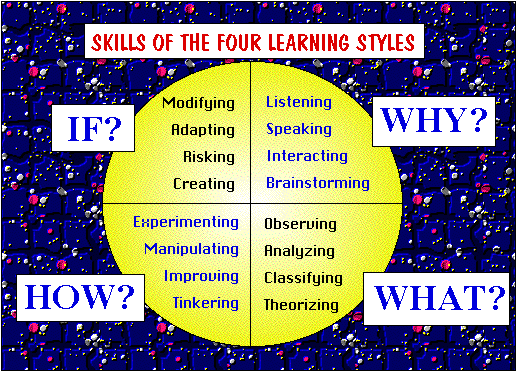
Citation: Huitt, W. (2009). Individual differences: The 4MAT system. Educational Psychology Interactive. Valdosta, GA: Valdosta State University. Retrieved [date], from http://www.edpsycinteractive.org/topics/instruct/4mat.html
Return to | Classroom Instruction | EdPsyc Interactive |
Overview
According to Bernice McCarthy, developer of the 4MAT system, there are four major learning styles, each of which asks different questions and displays different strengths during the learning process.

These styles are based on the work of John Dewey, Carl Jung, and David Kolb (St. Germain, 2002). The Index of Learning Styles Questionnaire developed by Solomon and Felder (Felder, 1993) provides data relevant to Kolb's learning theory. The Myers-Briggs Type Indicator (MBTI) and the Kiersey Temperament Sorter II define an associated theory for Jung's theory of personality style and temperaments. About Learning has developed a Learning Type Measure that directly addresses the four types of learners.
The Concrete-Random or "Imaginative Learner" demands to know "Why" he or she should be involved in this activity. This temperament is similar to the SP (Sensing/Perceiving) temperament in the MBTI. The Abstract-Sequential learner wants to know "What" to learn and is similar to the NT (Intuitive/Thinking) temperament. The Concrete-Sequential learner wants to know "How" to apply the learning and is similar to the SJ (Sensing/Judging) temperament. The Abstract-Random learner asks "If" this is correct how can I modify it to make it work for me. This is similar to the NF (Intuitive/Feeling) temperament. In the language of the ancient Greeks, these are the Sanguine, Choleric, Melancholy, and Phlegmatic temperaments, respectively. The DISC personality system has a similar categorization.
Each learning style is associated with both left- and right-brain learners. Left-brain learners are logical, rational, sequential, serial, verbal learners. Right-brain learners are intuitive, emotional, holistic, parallel, and tactile learners.
Instructional Events
The 4MAT system is designed to provide every student with a preferred task during every lesson. Listed below are the 8 instructional events proposed by this system.
|
|
|
|
WHY? |
|
1 |
|
Create an experience |
2 |
Analyze/reflect about the experience |
|
|
WHAT? |
|
3 |
|
Integrate reflective analysis into
concepts |
4 |
Develop concepts/skills |
|
|
HOW? |
|
5 |
Practice defined "givens" |
|
6 |
|
Practice and add something of oneself |
|
IF? |
|
7 |
Analyze application for relevance |
|
8 |
|
Do it and apply to more complex
experience |
Huitt (2000) provides suggestions as to how the 4MAT system can be used to develop online instruction.
Note: The 4MAT name and material are copyrighted as of 2009 by About Learning, Inc. All rights reserved. No additional reproduction or production allowed without the expressed written consent of the publisher, About Learning, Inc. About Learning, Inc.www.aboutlearning.com (800) 822-4MAT
References:
| Internet Resources | Electronic Files |
Return to:
All materials on this website [http://www.edpsycinteractive.org] are, unless otherwise stated, the property of William G. Huitt. Copyright and other intellectual property laws protect these materials. Reproduction or retransmission of the materials, in whole or in part, in any manner, without the prior written consent of the copyright holder, is a violation of copyright law.